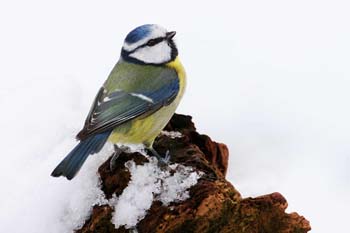Frequently asked questions
Blue Tit, by Jill Pakenham
If you can’t find the answer to your question here, email us at gbw@bto.org
I’m busy on 9th January – can I record on a different day?
We have chosen 9th January as it is in the first quarter of the moon phase, meaning the skies will be fairly dark. This allows us to judge the effect of artificial light sources without natural light sources (e.g. the moon) interfering. However, if you can’t record on this day, we will also happily take submissions from any day that week (Mon 6th- Sun 12th January).
How do I submit my results?
You can submit your results here.
What will the BTO do with these results?
We aim to publish findings of this study in a peer-reviewed scientific journal. Findings will also be relayed to participants via email and through BTO publications.
Why can’t I tell you about other species not on your list?
We are interested in the activity of the core garden bird community and have restricted our analysis to the 43 familiar species most likely to be encountered in a garden setting. If we were to expand this list to cover all possible species then it is likely that there will be some species that only a proportion of observers would be able to identify, which might introduce a bias into the results.
Is there a time limit on this survey?
No, there is no time limit. Preferably, if you can, we'd like you to watch your feeders until you see some birds but we're also aware that people have other things to be getting on with in the morning. If you can spare an hour after dawn then that would be great; if not, your observations will still be valuable. Please remember to record your start and end time.
What is ‘daybreak time’?
We’re asking you to get up before dawn so that you can start observing your bird feeding station before it gets light. This allows you to tell us what time you can first see your bird feeding station – noted on the survey as ‘daybreak time’.
What if I don’t get ten species of bird in my garden?
We know that many people aren’t lucky enough to get ten bird species in their garden, especially not first thing. However, we have to allow for those gardens that will have more species, so ten species should accommodate those people.
Can I record species feeding on berries in bushes/trees?
No, we're interested in those species feeding on, or below, your garden feeding station.
What if I don’t have a max/min thermometer?
If you don’t have a max/min thermometer, you can still participate in the survey. While we are interested in the temperature, it is more important that we get the artificial light information.
What is an artificial light source?
Sources of light that we are interested in are those that could add to light pollution in your area. These could include street lights, advertising signs, porch lights that are left on overnight or flood lights at sports fields/industrial buildings.
How do I measure a 50m radius from my house?
You
can download instructions here
Why don’t you differentiate between males or females, or adults and juveniles?
While male and female Blackbirds (for example) can be distinguished by most observers, there are other species that are more difficult to distinguish (or that cannot be distinguished at all). In order to avoid introducing any bias, we have restricted ourselves to an approach that will work across all species and observers.
I enjoyed recording the birds that I saw in my garden. How can I do more?
By joining the BTO Garden Birdwatch; you'll find more information on this project here.
Back to Early Bird Survey Home page







Share this page